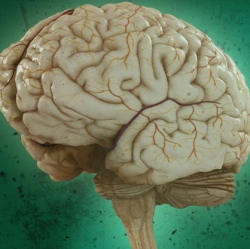
Chronic pain is often tough to understand, much less treat. But a new flexible, implantable electronic device could illuminate why certain parts of your body hurt. And down the road, the system, which features a wirelessly activated light-emitting diode (LED), might even be able to provide pain relief with the flip of a switch.
In a recent demonstration, the device’s inventors showed that it could be implanted in mice and used to manipulate neural circuits known to be involved in creating the perception of pain by using an emerging technology called optogenetics. The technique entails adjusting the DNA of neurons so they can be made to fire, or can be blocked from firing, by shining light on them. The researchers also showed that the implants could be left in for long periods of time without significantly damaging the tissue or impairing motor function.
A growing number of researchers are using optogenetics, a technology invented roughly a decade ago (see “Brain Control”), to more precisely understand how groups of interconnected neurons work together to carry out discrete functions. But the technique has generally relied on external light sources, limiting the targetable circuits to those near a part of the skeleton, such as the skull, where a rigid fiber-optic cable can be held in place and prevented from damaging delicate neural tissue when the animal moves.
The new implantable system, which is based on very thin, soft materials with mechanical properties similar to those of biological tissues, doesn’t need to be stuck to a bone. That’s important for scientists hoping to better understand chronic pain that emerges from the activity of neurons in the peripheral nervous system and spinal cord.
Robert Gereau, a professor of anesthesiology and director of the pain center at Washington University in St. Louis, says he and his colleagues were trying to figure out how to avoid the need to tether animals to a fiber-optic cable a couple of years ago when a group led by John Rogers, a professor of materials science and engineering at the University of Illinois at Urbana-Champaign, demonstrated flexible and implantable microscale LEDs they could turn on wirelessly and use to influence brain activity in mice (see “Wireless Micro LEDs Control Mouse Behavior”).
The two groups teamed up to develop an iteration of the implantable micro-LED that could be used to study circuits in the peripheral nervous system and spinal cord. Key to the new design is a tiny, stretchable antenna that harvests energy from radio frequency signals to power the device. In the previous design, the antenna had been larger and had to be fixed to the mouse’s skull.
The researchers implanted the devices in mice, either over the sciatic nerve, which runs from the lower end of the spinal cord down the back of the lower limb, or in the so-called epidural space above the spinal cord. In proof-of-concept experiments, the group showed that by shining the light on groups of neurons thought to be involved in pain and modified to be light-sensitive, they could induce behaviors associated with pain.
Gereau says the new technology will open the door to investigations into “some very long-standing questions” about how sensory information is processed in the spinal cord, and help identify the specific roles of the different types of neurons thought to be involved in pain. A better understanding of the underlying biology might lead to new therapies that use optogenetics to target specific neural circuits, says Gereau. “How can we manipulate them to reduce the burden of chronic pain?”
